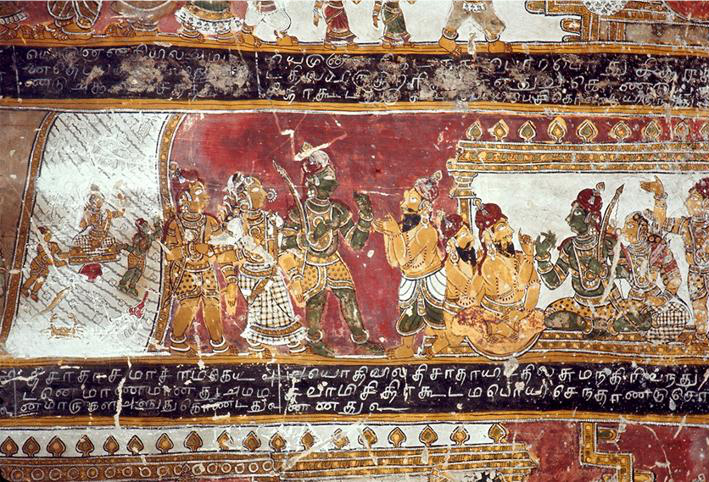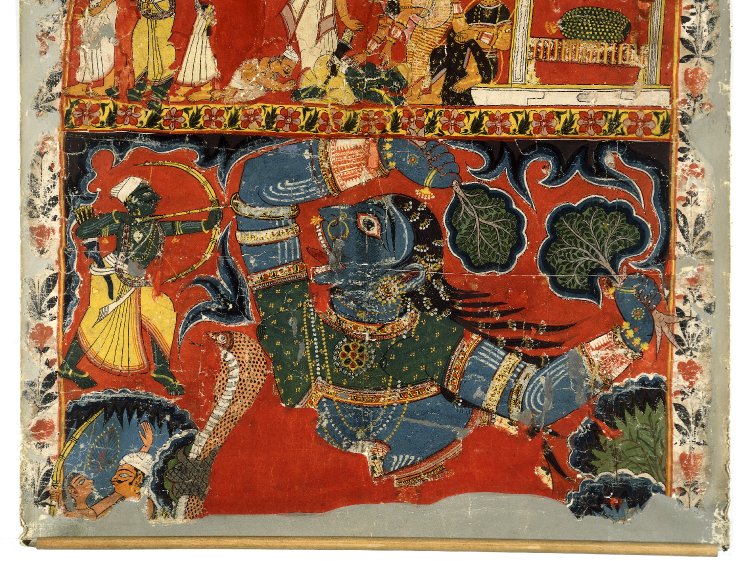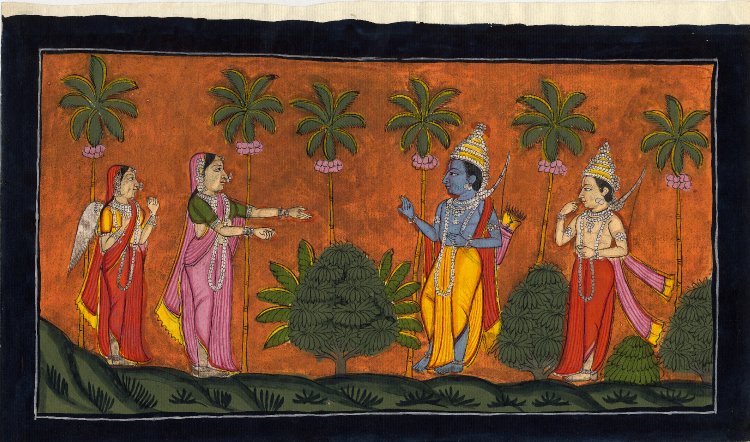The use of imagery in any great epic is not accidental. Especially in such a visual and tangible culture as that of India, the use of any color was carefully chosen for the sensation it would induce in the reader or listener. In this project I have examined the importance of the color of Rama’s skin in the Ramayana, and why it is described in the ways that it is. The depiction of Rama is so vast and diverse, it is important to point out the impossibility of fully understanding the complexity of Rama’s skin color. Any understandings of color meanings can be used to interpret the character of Rama. This is a character with quite an extensive history, and a seemingly infinite number of different portrayals and interpretations, all of which are completely valid. To say that there is one explanation of Rama’s skin color would be to erase the vast majority of opinions mentioning otherwise.
The use of color in Hinduism is not just a visual experience but also a spiritual and sensational experience. The Sanskrit words for color can also refer to more general qualities, making the use of color very symbolic. Perspectives of color in Hinduism are much more complex than simple western visual experiences. In the west, Patti Bellantoni suggests “it is not we who decide what color can be. …it is color that can determine how we think and what we feel.”5 Regarding the experience of color in Hinduism, Jessica Frazier writes that “color is part of the complex of ideas, including modification, disposition, taste, and shape, that express the notion of a distinctive tangible quality or mode of something, whether that thing is a medium, a person, or reality itself.”³ Hinduism is presented as a “kaleidoscope of images”, not simply for visual pleasure but with purpose.¹ This is clear in the Ramayana, where upon reading, one faces the scrupulously detailed descriptive imagery and is invited deeper into understanding the experience of the story, with all imaginary senses, inducing emotions, perspectives, and states of mind. In the Rig Vedas, colors were rarely mentioned as their own words, but rather epithets, which “are not designations of color at all, but simply imply or suggest it.”6
The theory of the aesthetic experience of rasa is also important to note in this discussion. G. B. Mohan Tampi writes that “the word rasa denotes, apart from the reader’s aesthetic experience, the creative experience of the poet and the essence of the totality of the qualities which make a poem what it is.”7 Thus, there is no color or visual description that becomes canonized without significant reason or background.

Sri Andal Temple Car, Srivilliputtur, India.
I am primarily concerned with the depictions of Rama’s skin color. Sometimes it was portrayed as green, other times it was blue. Rama’s skin was depicted as green in William Buck’s translation of Valmiki’s Ramayana, and a painting on the Sri Andal Temple Car in Srivilliputtur, Tamil Nadu, India, as shown above. In Valmiki’s Ramayana, Rama is depicted as having “colorful green eyes; his skin was cool soft green … his wavy hair was dark green”.² But in Tulsidas’ Ramcharitmanas, he is described as having blue skin.
According to the color-mood correlations of the Bharata Natyam dance, Rama could be described as either passionate or disgusted/disgusting, depending on where you are. Laksmana’s golden skin could be interpreted as being heroic and/or amazed, most likely by Rama. Hanuman, the white monkey, is known for being a clever trickster. The comic mood of white suits him. More popular sources, such as zeenews, sanskritimagazine, and empower-yourself-with-color-psychology.com could tell us that Rama’s skin is green because he represents happiness and is a manifestation of God, or that his skin is blue because he is a symbol of power and life. Or, that Rama’s skin was green until green became synonymous with Islam, and thus it was changed by popular practice to blue, to be associated more with Visnu. The variability is seemingly endless.
The use of color in South Asian traditions usually indicates something much deeper than just color. These traditions have created “a worldview that sees color-coded dispositions as pervading the phenomenal world and offering hints as to the rules that govern it.”³ All colors are up to interpretation, but different colors signify different dispositions, qualities, or moods, depending on the audience. For instance, green is the color of the passionate mood. White is for the comic mood, gold is for the heroic mood, and yellow is for the mood of amazement. The mood of disgust is blue. These are how the colors are used in the dance of Bharata Natyam, but they were carefully chosen because of their significance and background with other similar emotions.³ Certain popular websites4 suggest that green is the color of happiness, nature, and new beginnings, and could even be a manifestation of God. White could be the color of serenity and separation from the materialistic world. Blue, the color of power and life; yellow, the color of healing and holiness. Neither of these interpretations is incorrect. The variability of interpretation is something that cannot be escaped in the study of religion, and all interpretations are valid and should be considered. Ultimately, the answer will always be yes and no, but an increase in research on the subject could give valuable insight on the visual and aesthetic experience of rasa, of Hindu performance art, and of Indian epic poetry.
Works Cited:
- Eck, Diana L. “Image, Temple, and Pilgrimage.” Darsan: Seeing the Divine Image in India. New York: Columbia University Press, 1998. 59-75.
- Buck, William. Ramayana. Berkeley And Los Angeles, California: University Of California Press, 1976. Print.
- Frazier, Jessica. “Colors.” Brill’s Encyclopedia of Hinduism. Edited by: Knut A. Jacobsen, Helene Basu, Angelika Malinar, Vasudha Narayanan. Brill Online, 2014. Reference. University of Vermont. 23 October 2014.
- Bellantoni, Patti. If It’s Purple, Someone’s Gonna Die: The Power of Color in Visual Storytelling. Burlington, MA: Focal Press, 2005. Sfx.uvm.edu. Web. 16 Nov. 2014. p. xxvii
- Hopkins, Edward W. “Words for Color in the Rig Veda.” The American Journal of Philology, Vol. 4, No. 2 (1883), pp. 166-191. The Johns Hopkins University Press.
- G. B. Mohan Tampi. “‘Rasa’ as Aesthetic Experience”. The Journal of Aesthetics and Art Criticism, Vol. 24, No. 1, Oriental Aesthetics (Autumn, 1965), pp. 75-80


